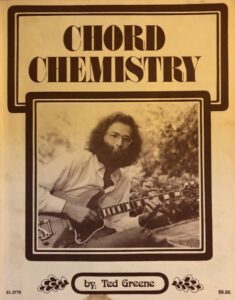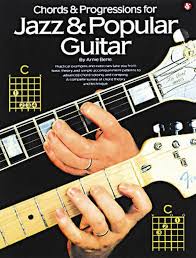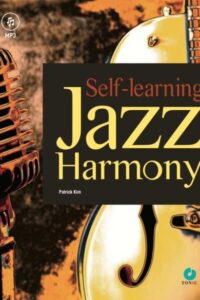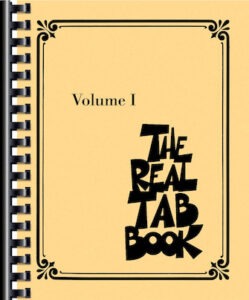Table of Contents
Chord Chemistry, by Ted Greene.

As in any field of study, countless volumes have been written about music. With the increasing popularity of the guitar, particularly in the last 50 years, a wealth of guitar literature has been established, much of it penned by the instrument’s greatest masters. Today, many of us learn from teachers, in person, but truth be told, if we were all well-disciplined, self-motivated students, we could learn everything we would ever need to know about the guitar from books. Although it is immensely helpful to have a teacher synthesize and communicate this information, some books hold a special knowledge only receivable though the intimate reading, studying experience.

Best Sheet Music download from our Library.
In the “books” section of Riffs of Wisdom, I will shed light on some literature that could greatly help all guitarists on their journey towards musical nirvana. Some will be advanced, theoretical books, some will be instructional methods, some will be important collections of scores, and some will just be plain fun reads! Ultimately, these books have helped me gain many Riffs of Wisdom, and will hopefully teach you a few too.
Please, subscribe to our Library.
If you are already a subscriber, please, check our NEW SCORES’ page every month for new sheet music. THANK YOU!
The book we’re writing about now is a guitar classic, and can be found in many guitar players’ bookshelves – “Chord Chemistry,” written by Ted Greene. Although Ted wrote four significant works about the guitar, this is by far his most well known. Ted was primarily a solo, finger-style guitarist. He is most commonly depicted with a vintage Telecaster, and Fender amp, staples of his signature tone. A master of music theory and harmony, Ted became famous for his intricate solo guitar arrangements, often turning Jazz standards, Pop tunes, and Beatles’ songs into gorgeous guitar ballads.

He also was well known for his mastery of the blues, on which he could improvise endlessly, implementing walking bass lines, harmony, and melody. Much like his contemporary, Lenny Breau, Ted was also well known for his use of artificial harmonics and close-voiced harmony, similar to that of a pianist. Overall, he was an amazing, unique player – check him out on YouTube.
Come join us now, and enjoy playing your beloved music and browse through great scores of every level and styles!
Can’t find the songbook you’re looking for? Please, email us at: sheetmusiclibrarypdf@gmail.com We’d like to help you!

But more so than a player, Ted was a great student of the guitar – and as a result, a great teacher. Ted had Asperger Syndrome, a mild form of Autism, that made him an extreme introvert and an obsessive person. Ted hardly left his apartment (his number of public performances can be counted by hand), and his greatest obsession was studying the guitar.
He hosted a vast number of students in his guitar den, which was cluttered by stacks upon stacks of papers, many pertaining to his studies. He would conduct in depth analyses of J.S. Bach, Wes Montgomery, and different musical styles. He could improvise any tune in accurate Baroque styling, and had an impeccable ear for harmony. Many students were fortunate enough to learn from this guitar master in person, but for the rest of us, Ted left four jam packed books – Chord Chemistry, Modern Chord Progressions and the two part Single-Note Jazz Soloing. And although these books may seem thin, they are dense!

As Ted writes, Chord Chemistry “examines chords and their application.” This is not a beginner’s book, but Ted makes an effort to bring the reader up to speed, explaining different chord types and their purposes. The rest of the book is an attempt to translate Ted’s complex harmonic language. Some of the most valuable sections discuss specific chord substitutions, when they are appropriate, and the effect they will have. There is also a dense portion of the book where Ted diagrams all of the chord voicings he uses – and believe me, you would not have thought of many of these! They are also important sections about the Blues, right-hand technique, Rock progressions, and counterpoint.

Overall, this book is dense! Don’t expect to take it all in the first time. It’s been on my bookshelf for years, and I constantly revisit it, always learning something that I couldn’t previously comprehend. If you put in the time and effort, this book will greatly help you progress, not only on your guitar, but on your journey towards musical nirvana.
“Nobody loses at guitar if they put in the time. Something good always shows up. It’s all consistent with life’s big lessons. Patience. Determination. Love. Goals. Finishing a job.” – Ted Greene
Check out the Ted Green website for more info.
Browse in the Library:
Or browse in the categories menus & download the Library Catalog PDF:
Who was Ted Greene?
Ted Greene, Theodore Greene (September 26, 1946 – July 23, 2005) was an American fingerstyle jazz guitarist, columnist, session musician and educator in Encino, California.
Career
Greene began his own guitar studies at the age of 11, and was an accomplished player while still in high school, occasionally collaborating with local rock and R&B bands. He briefly studied accounting at California State University, Northridge, but dropped out to devote his time to music.
In the 1960s, he was a member of the rock band Natural Selection and a blues rock group called Bluesberry Jam, which included future Canned Heat drummer Fito de la Parra. He was a friend and collaborator with Joseph Byrd, on whose Columbia Masterworks album The American Metaphysical Circus he was featured (he also provided the whimsical name of the studio band who performed it, “The Field Hippies”). During the late 1960s and early 1970s he did commercial studio work with Byrd.
He was again called on in 1977 to provide guitar tablature for three arrangements of Bix Beiderbecke’s piano music for the Ry Cooder album Jazz, which Byrd arranged and produced.
Although Greene is often regarded as a jazz musician, he played many musical styles. He was known to guitarists for his role as a music educator, which included private teaching, seminars at the Guitar Institute of Technology, columns for Guitar Player magazine, and his instructional books on harmony, chord melody, and single-note soloing.
A voracious reader of almost any book on music theory, especially from the common practice period (circa 1600–1900), he distilled complex concepts regarding the structure of western music. He would write out more accessible versions for students to understand (handed out to students in the form of lesson “sheets”), often applying keyboard concepts to the guitar. For example, many transcriptions of the chorales of J. S. Bach would be re-written for guitar with useful analysis applicable to any musical setting.
He would also make occasional live appearances at clubs in the San Fernando Valley, usually playing a Fender Telecaster.
Greene typically worked as a vocal accompanist, which he preferred because he found group settings restrictive. While he was a sought-after session musician, he derived much of his income from tutoring. He wrote four books on the subject of jazz guitar performance and theory: Chord Chemistry, Modern Chord Progressions: Jazz and Classical Voicings for Guitar, and the two-volume Jazz Guitar: Single Note Soloing.
His playing style included techniques such as harp-like arpeggios combined with gentle, tasteful neck vibrato, creating a “shimmer” to his sound. Other notable techniques included playing songs with a walking bass line with simultaneous melodies. Greene used counterpoint to improvise in a variety of styles, playing, for instance, a jazz standard such as Autumn Leaves in Baroque style. He used a large variety of chord voicings, often creating the effect of two simultaneous players.
Greene recorded one album, Solo Guitar, which was produced by William Perry and Leon White, and released in 1977 on PMP Records. The album contains no overdubbing (recording on multiple tracks).
Although not well known to the public, Greene was respected by guitarists. Guitarist Steve Vai has praised Greene’s musical knowledge and perceptiveness on Solo Guitar, stating that Greene “is totally in touch with the potential of harmonic constructions” which allows him to create an “organic and inspired listening delight.”
In a 1982 discussion with Robert Fripp, John McLaughlin described Greene as “really unbelievable”, noting that “it’s so difficult to move around on a guitar in the harmonic way one can do on a keyboard…He’s the only guitar player who accomplishes this thing that really turns me on.”
Ted Greene: Sound, Time, and Unlimited Possibility, by guitarist Terrence McManus, published in 2015, is the most complete analysis of Greene’s work that exists.
Greene helped Fender design a 1952 Telecaster vintage reissue (their first such reissue) by making reference to his collection of old Telecasters, Esquires, Broadcasters and Nocasters.
Greene died in his apartment in Encino of a heart attack at the age of 58. In 2009 Barbara Franklin wrote the biography My Life with The Chord Chemist: A Memoir of Ted Greene, Apotheosis of Solo Guitar. She died on August 13, 2011.
Discography
- The American Metaphysical Circus by Joe Byrd and the Field Hippies (1969)
- Solo Guitar (Art of Life, 1977)
- Among Friends by John Pisano (1995)
- Conversation Pieces by John Pisano (1997)
- Mojo Blues by Will Ray (2002)
- John Pisano’s Guitar Night by John Pisano (2007)
Publications
- Chord Chemistry, Alfred Publishing Company
- Modern Chord Progressions, Alfred Publishing Company
- Jazz Guitar Single Note Soloing, Volume 1, Alfred Publishing Company
- Jazz Guitar Single Note Soloing, Volume 2, Alfred Publishing Company
- My Life with the Chord Chemist: A Memoir of Ted Greene, Apotheosis of Solo Guitar by Barbara Franklin
- Ted Greene: Sound, Time, and Unlimited Possibility by Terrence McManus
